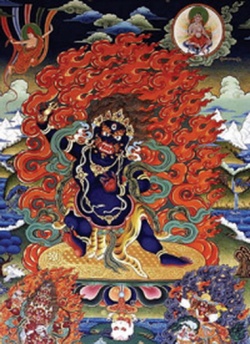Chinese Manifestations of Tibetan Buddhas - Vajrapani
One of the most wonderful dimensions of the Mahayana Tradition of Buddhist practice and teaching are the different manifestations of Buddha’s Qualities of compassion and wisdom. These emanate as different Buddha deities. The form, appearance, costumes, mudras, implements and jewellery of these Buddha deities differ quite considerably under Chinese & Tibetan Buddhism. Chinese & Tibetans follow the Mahayana tradition and we bring you images of five of the more popular Tibetan Buddha deities in their Chinese manifestation.
Vajrapani – Lord of the Secret Vajrapani is a Bodhisattva with a wrathful face. To those who are new to Mahayana Buddhism, he does not look very Buddha like. But Vajrapani is indeed a Bodhisattva who embodies all the Buddhas' infinite enlightened power.
He is shown dancing wildly inside a halo of flames, which signifies transformation. He holds a vajra (a diamond scepter) in his right hand, emphasizing the power to cut through the darkness of delusions. Both his hands are in the threatening mudra which he uses to overcome hindrances. He is deep-blue in color and wears a tiger-skin cloth wrapped around his waist. This is the emblem of his fearlessness. Vajrapani looks wrathful, but as a representation of the enlightened mind, he is completely free of anger and hatred. Buddhahood brings to fruition the three essential qualities of compassion, wisdom and power, the last of which is also referred to as skilful means.
The need to cultivate all three to benefit others is illustrated by the following analogy. Suppose we were to witness an accident in which a young boy falls into a river and is in danger of drowning. Even if the child is not ours, it is very easy to develop compassion for him because seeing the helpless boy arises in us the heartfelt wish that he be rescued quickly. We may also have a clear understanding of what caused the danger and what must be done to save the child – this understanding itself is a form of wisdom. But if we are crippled or weakened by disease or hindered in any other way, all our compassion and wisdom is of no use; we cannot be of any real help to the drowning child.
Same, if we are to be of true benefit to all beings, we need more than compassion for their suffering, and more than the clear wisdom that understands the cause of that suffering; we also need to be endowed with the skill and ability required to put our compassion and wisdom into action. This entails, among other things, knowing the predispositions of those we are to help and having an intuitive understanding of which approach will bring about the intended benefit most effectively. If we are unskilled, then despite our good intentions, it is easy to make matters worse and to be of no help at all.
Therefore, along with the compassion and wisdom personified by Avalokiteshvara and Manjushri, a bodhisattva practitioner must also cultivate the power and skillful means of Vajrapani.
Numerous stories are told of the powerful means Vajrapani uses to protect and promote Buddha's teaching. On one famous occasion, Shakyamuni Buddha was seated at the Vulture's Peak near Rajagriha, the site where He delivered the Perfection of Wisdom Sutra. At that time, Buddha's jealous cousin Devadatta rolled a large boulder down the hill in an attempt to assassinate Him. Just as the huge rock was about to crush Buddha, Vajrapani used his immense power to split it into two so that pieces of the boulder fell harmlessly to either side.
In recognition of Vajrapani's powerful abilities, Shakyamuni Buddha entrusted him with the protection of the tantras, those powerful Vajrayana teaching capable of guiding qualified disciples to full enlightenment in one short lifetime. As protector of these precious and esoteric tantric teachings, Vajrapani is sometimes referred to with the title "Lord of the Secret".
